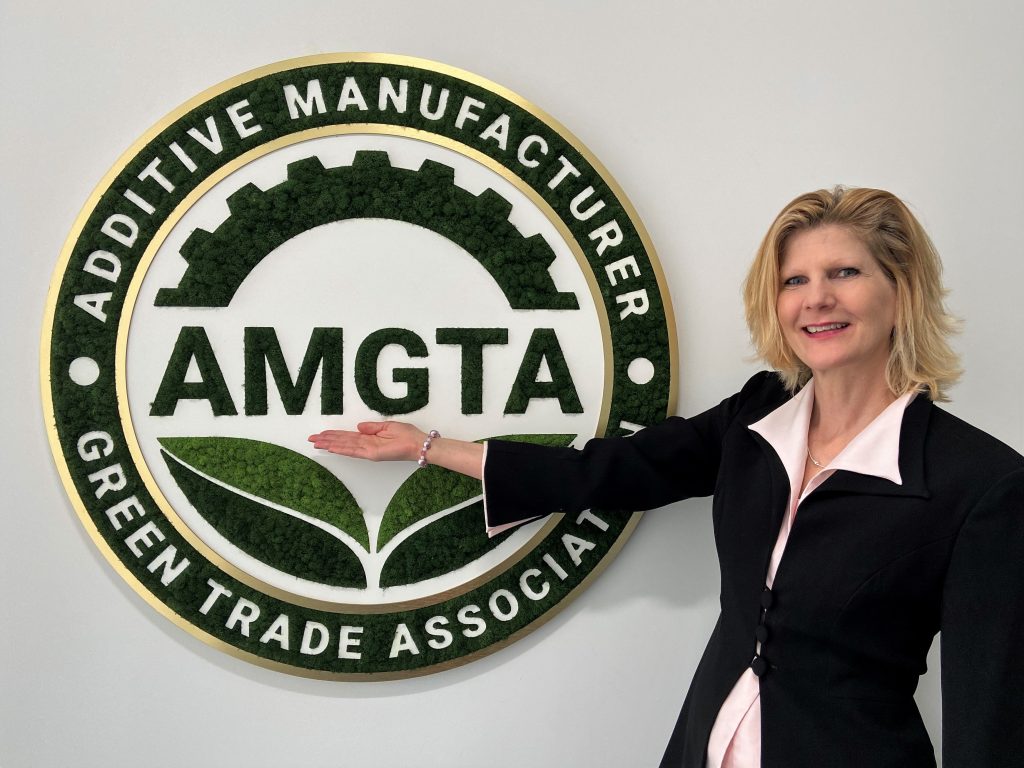The pandemic has resulted in increased consumer awareness of how a supply chain works. Climate change and environmental degradation are in the news and top of mind. Product companies and manufacturers are looking for ways to produce products in a more sustainable fashion, minimizing waste and pollution. All roads seem to lead to additive manufacturing and Sherry Handel.
Handel is the executive director of the Additive Manufacturer Green Trade Association (AMGTA). Founded in November 2019, the AMGTA promotes the environmental benefits of the additive manufacturing world. Handel is the non-profit’s first executive director.
What is additive manufacturing?
Most people are probably more familiar with the term “3D printing”. Additive manufacturing, or AM, is simply 3D printing on an industrial scale. Whatever you call it, it’s a process used to create a product or part by gradually adding additional material in a final or near-final shape. Unlike traditional subtractive manufacturing, which whittles down a large piece of raw material into a final shape, additive manufacturing effectively “grows” raw material into a final shape in a single step.
It’s an emerging field. Researchers are still developing and discovering new processes, technologies and materials. For example, many people might envision 3D printing as small plastic printed products and parts. Today’s additive manufacturing world includes a variety of polymers, metals, composites and other materials. Additive manufacturing can produce products as big as a house, literally.
A growing industry of additive manufacturing
Despite the global pandemic, the industry grew almost 7.5 percent and generated about $12.8 billion in revenue in 2020. “There are several reasons for this continued growth,” says Handel. Additive manufacturing “enhances the functionality of parts and products. It enables local manufacturing, and it significantly reduces time-to-market. It’s revolutionizing the design and manufacturing process.”
According to Handel, there are many reasons for the increased adoption of additive manufacturing. Additive manufacturing offers many advantages over traditional manufacturing. It can be more cost-effective. It can reduce waste, both during the manufacturing process and in transit. (Additive can create parts and products closer to their end destination, reducing shipping costs and environmental impact.) It allows companies to shorten their lead times in the production cycle. They can do away with the need for expensive mold making, tooling and dies. In addition, the cost of 3D printers has dropped significantly.
Environmental benefits
As companies weigh their manufacturing options, innovative new assessments and cost models are helping fuel the adoption of additive manufacturing. A life-cycle assessment (LCA) is a comparative study that helps companies to evaluate the environmental impact a part or product has throughout its entire life-cycle. This includes the manufacturing process that produces it. This is very important, as 19 European countries have implemented carbon taxes and some municipalities are starting to assess companies for their contribution to excess waste.
Additive manufacturing allows designers and engineers to simplify product and part designs. The AMGTA’s State of Knowledge of the Environmental Impacts of Metal Additive Manufacturing report, published in November 2020, found that a GE engine that originally had 422 parts could be reduced to just 12 parts through the use of AM. Streamlined and efficient production of products and parts can reduce waste, energy use, emissions, and costs.
Launching research
The AMGTA recently established the Sustainability of Additive Manufacturing Research Fund, a $100,000 fund that benefits the Yale School of the Environment. The fund will support research at the Center for Industrial Ecology on the sustainability benefits of binder jet additive manufacturing using life-cycle assessment (LCA) tools and modeling. This new fund will be used to conduct LCA research that compares several conventionally manufactured metal industrial parts with those designed and manufactured via the binder jet additive manufacturing process. This LCA research report is expected to be published in the fall of 2022 and the key findings will be announced at that time.
At the RAPID + TCT additive manufacturing conference on Sept. 13, the AMGTA issued a press release announcing that it had commissioned the Golisano Institute for Sustainability at Rochester Institute of Technology to conduct its first life-cycle assessment research project. The research will compare an additively designed and manufactured aerospace component to a traditionally manufactured component. This project will quantify where powder bed fusion AM technology results in lower environmental impacts in an aerospace component’s life cycle, as compared to older manufacturing methods. The LCA report will be peer-reviewed by a panel of three LCA experts to ensure methodology, data, assumptions, results and conclusions are accurate. The report will be published in the spring of 2022, and the key findings will be announced at RAPID + TCT in May 2022.
AMGTA member education
The COVID-19 pandemic limited in-person industry gatherings around the world. Because of that, the AMGTA had to get creative about how it engages and educates its members. The current approach includes more frequent member touchpoints, including email notifications, video conferences, monthly newsletters, social media posts and member-only virtual forums. Together, AMGTA members can discuss their companies’ environmental sustainability initiatives, goals and milestones and ideas on how to advance eco-sustainability in the additive industry. Handel is an expert speaker on the topic of Sustainability in Additive Manufacturing. To date, she has spoken at 17 industry forums and events.
The AMGTA has grown to 31 members from 10 countries. It represents the entire additive manufacturing industry, including manufacturers, material suppliers, design and software solution providers, machine manufacturers, post-processing companies, ecosystem hubs, consulting firms and research institutions. AMGTA member companies are genuinely concerned with employee and customer expectations around environmental sustainability.
Throughout the pandemic, interest has only increased in AM. More companies are feeling the pressure to cut production costs and waste. The AMGTA seeks members who are committed to “greening” their production process, product or service offerings and supply chain.
More women in additive manufacturing
One of Handel’s interests is to see more women employed in the additive manufacturing industry. She recommends Women in 3D Printing (Wi3DP) as a valuable resource for any woman in the field or those considering working in the AM industry. Wi3DP is a global organization dedicated to promoting, supporting and inspiring women who are using additive manufacturing technologies. It aims to close the gender gap in AM to the point where women will one day account for half of all workers in the industry. This is a long way from the current 13 percent. Still, Handel’s own role is a terrific example of the heights women can reach in this industry.
If you want to hear more from Handel, make sure to register for Barcelona New Economy Week (BNEW), a virtual conference in Barcelona, Spain. Handel will be speaking on the “Sustainable Solutions in 3D: Increasing the Ecological Footprint of the Planet” on Oct. 8. You can also see Handel speak at the Advanced Manufacturing Technology Conference (AMTC) in Aachen, Germany on Oct. 12-14. AMTC is the world’s most influential C-level conference highlighting AM. Handel will be speaking on the “International Coordination of AM Initiatives” panel discussion on Oct. 13.
For more resources on additive manufacturing, visit amgta.org/resources. If you’d like to join the AMGTA or learn more about the association, visit amgta.org/contact.
Want to read more about up-and-coming tech? Watch our interview with Liz Gazda to learn about the Embr Wave, a wearable personal thermostat that controls your body’s temperature.






Add Comment